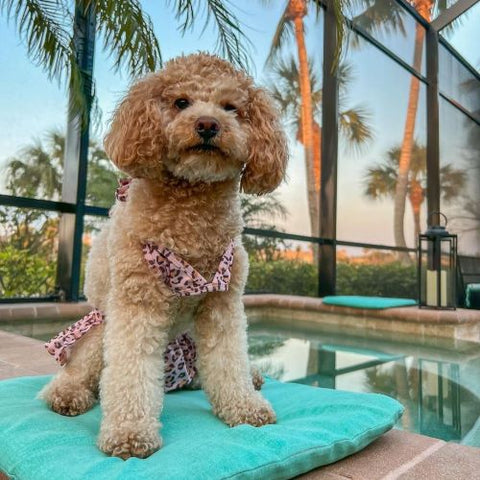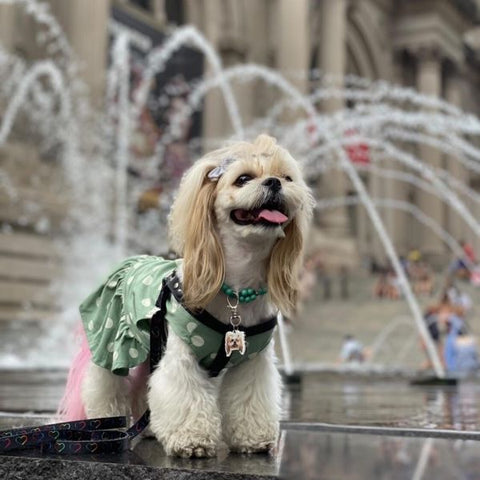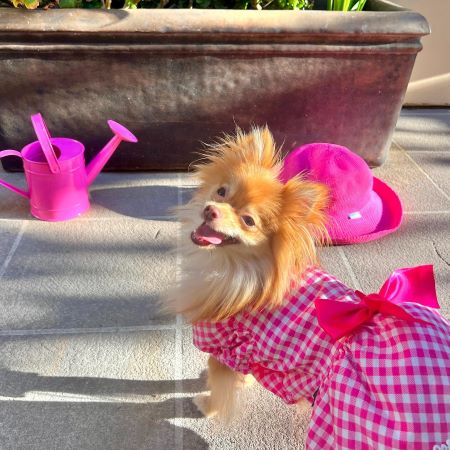How Often Should You Wash Your Dog
Keeping your dog clean and groomed is an important part of being a responsible pet owner. However, when it comes to bathing, many owners wonder just how often they should be washing their furry friend. While every dog is different, there are some general guidelines you can follow to determine the optimal bathing frequency for your pup. Things like breed, age, coat length, skin sensitivity, and activity level all play a role. Bath time provides an opportunity to bond with your dog, check them over for parasites or skin issues, and of course, make them smell fresh again. Following proper bathing routines can greatly benefit your dog's health and quality of life. This article will cover the factors that determine bathing needs, signs it's time for a wash, tips for bathing safely, and the advantages it provides for your dog.

The Many Benefits of Regular Doggy Baths
1. Keeps Their Coat Clean Regular baths remove dirt, debris, and odor-causing bacteria from your dog's coat to keep it looking and smelling fresh and clean.
2. Promotes Healthy Skin Bathing washes away allergens, excess oils, and dead skin cells while providing moisture to nurture their skin health.

Instagram: honeytheminipoo
3. Reduces Shedding The motion of bathing helps loosen old hair that can then be rinsed away instead of ending up all over your house.
4. Reveals Skin Problems Bath time gives you the chance to inspect for any bites, hot spots, rashes or other skin issues your dog may have.
5. Prevents Parasites Thorough rinsing can help wash away parasite eggs or larvae to prevent problems like fleas, ticks or mange down the road.

Instagram: wakanda_shihtzu
6. Curb Doggy Odor Removing built-up sweat, oils, and dirt on their coat keeps your dog smelling fresher longer between baths.
7. Relieves Itching For dogs with allergies, medicated baths can soothe and calm irritated, itchy skin.
8. Strengthens Your Bond For most dogs, bath time is positive one-on-one time with their beloved owner.

Instagram: iggychelseaandme
9. Reduces Anxiety Some dogs become more relaxed and less fearful of baths when made part of a consistent routine.
What Are the Factors That Determine How Often Dogs Need Bathing?
There are a few key things that determine how frequently your pup needs sudsing up:
-
Breed - Some breeds just tend to be stinkier! Dogs like retrievers, Basset Hounds, Poodles and Cocker Spaniels naturally produce more oils so need more regular baths. Breeds with drier skin like Greyhounds or Dalmatians only need occasional washing.
-
Age - Young puppies and senior dogs tend to need less frequent bathing, maybe just a few times a year, since their skin is more sensitive. Too much washing can cause dryness or irritation. Adult dogs need regular bathing based on other factors.

Instagram: deo_piper_cavoodles
-
Coat Length - Short-haired pups typically only need a bath every 4-6 months. Their coats don't hold onto dirt and grime as much. Long-haired breeds need more frequent sudsing, about every 3 months, to prevent mats and tangles.
-
Activity Level - Dogs that spend more time playing outside and getting into stuff need more baths to wash away all that dirt, mud and gunk. Indoor dogs may only need a few yearly baths.
-
Skin Conditions - Dogs with allergies, infections or other skin issues may need medicated baths as often as once a week. Always follow your vet’s recommendations for dogs with skin problems.
How to Tell It's Time to Bathe Your Dog
1. If you notice clumps of mud or dirt stuck in their fur, especially around their paws, tummy, or booty - it's bath time! Dogs love to get messy when playing outside.
2. Ever sniff your pup and get a strong "doggy" odor even right after a brushing? That stinky smell means it's time to wash away built up oils and funk in their coat.

Instagram: friendly.faith.the.morkie
3. Finding dog hair all over your clothes and furniture lately? Heavy shedding is a clue that bathing will help loosen and rinse away that dead fur.
4. Does their coat look greasy, limp and dull even though you just brushed them? A healthy shine comes from a little oil, but too much makes their fur look grimy. Bathing will take away the excess grease and bring back the lustrous coat you love.
5. See any dandruff flakes or red, irritated patches of skin? This could indicate a skin issue that needs medicated bathing for relief.

Instagram: hattiemaethemorkie
6. Catch your dog obsessively licking or scratching parts of their skin and fur? This is usually a sign of discomfort from dirt, pests or skin irritation that a good bath can help wash away.
How Often Should You Bathe Your Dog?
When it comes to bathing your furry friend, every dog is different. But here are some general tips on bathing frequency for adult dogs:
-
Adult dogs with typical coats: Bathe every 3-6 months. Most healthy adult dogs only need a few baths a year to keep their skin and coat in good shape. Too much bathing can dry out their skin.
-
Puppies under 6 months: Bathe every 3 months. Puppies tend to get dirtier faster but too much bathing can irritate their sensitive skin. Stick to once a season.

Instagram: matildarosegoldendoodle
-
Senior dogs over 10 years: Bathe every 2-3 months. Older dogs are often less active but may need more baths to remove dead hair and skin cells as their coat and skin changes. Don't overdo it though.
-
Dogs with skin issues: Frequency as recommended by your vet. Medicated baths are often prescribed for skin conditions like allergies or infections. Follow your vet's guidelines.
-
Long-haired dogs: Bathe every 3 months. Those thick coats hold more dirt and oils so they need a little more bathing than short-haired pups.

Instagram: friendly.faith.the.morkie
-
Active, muddy dogs: Bathe every 2-4 months. Dogs that spend more time playing outside may need more baths to stay clean. Watch for dry skin.
These tips are helpful guidelines, but you may need to adjust based on your dog’s unique needs and response to bathing. Pay attention to their skin and coat to find the ideal bath schedule.
Bathing Your Pooch? Follow These Tips
1. Use dog shampoo: Human shampoo is formulated at the wrong pH for a dog's skin and can cause dryness, irritation, and skin damage over time. Always opt for a gentle, veterinarian-recommended dog shampoo made specifically for their pH balance. Look for soothing ingredients like oatmeal, aloe, and vitamin E.

Instagram: all_cali_cuteness
2. Use warm water: Avoid using hot water than can burn sensitive doggy skin. However, bathing with warm water helps relax muscle tension, loosen dirt and debris, and keeps them from getting too chilled during the bath. Check that the water feels pleasantly warm, not hot, on your wrist before wetting your dog.
3. Keep water out of eyes and ears: Use cotton balls, a washcloth, or your hand cupped gently over the ear canal openings to prevent water from getting inside while bathing. Be extremely careful not to get shampoo or water in their eyes as well, which can cause burning and irritation. Gently wipe the eyes with a soft, wet cloth if needed.
4. Rinse thoroughly: Make sure to completely rinse off all traces of shampoo residue after washing. Leftover shampoo that isn't fully rinsed can be irritating or damaging, especially to sensitive areas like the eyes, nose, and genitals. Rinse until the water runs clear.

Instagram: spoiledmaltesepups
5. Dry completely: Let your dog shake off the excess water first, then use soft towels to gently pat their coat until fully dry. Take extra care to thoroughly dry between skin folds, armpits, and any other area where moisture or dampness can lead to infection.
6. Brush before and after: Brushing before a bath helps loosen and remove shedding hairs and dirt from the coat. Brush thoroughly after a bath to smooth and detangle the clean coat and evenly distribute their natural oils again.
7. Check skin afterwards: Carefully observe your dog's skin following a bath to look for any signs of irritation, sensitivity or redness which could indicate the shampoo was overly harsh. Contact your veterinarian promptly if you have concerns.

Instagram: tinygirllisa
8. Offer praise and treats: Baths can be stressful for some dogs, so offer lots of verbal praise, pets, and yummy treats during and after to make it a calm, positive experience for your pup. This can help reduce bath time anxiety.
Washing Your Dog: Tips for a Healthy, Happy Pup
Bathing your furry friend regularly is so important for keeping them healthy, clean, and content! While the ideal bath schedule varies from dog to dog, most adult pups need a wash every 3-6 months. Senior and young puppies may need less frequent baths. Pay attention to your dog's unique needs and look for signs like stinky odors, heavy shedding, or skin irritation indicating it's time for a cleaning. Use a gentle, veterinarian-recommended dog shampoo and be sure to keep water out of their eyes and ears. Rinse thoroughly and take care to dry their coat completely when finished. Done right, bathing provides huge benefits - freshening up their coat, preventing parasites, spotting skin issues early, and strengthening your special bond. Work with your vet to tailor the perfect bathing routine for your pup. With some simple guidance and attentive care from you, bath time can be a safe, rewarding experience for both dog and owner! Proper grooming is key to your dog’s health and happiness.

Instagram: gailitdiane














